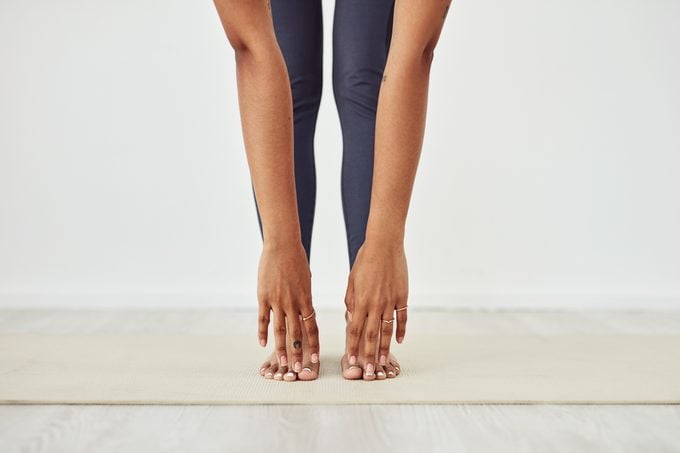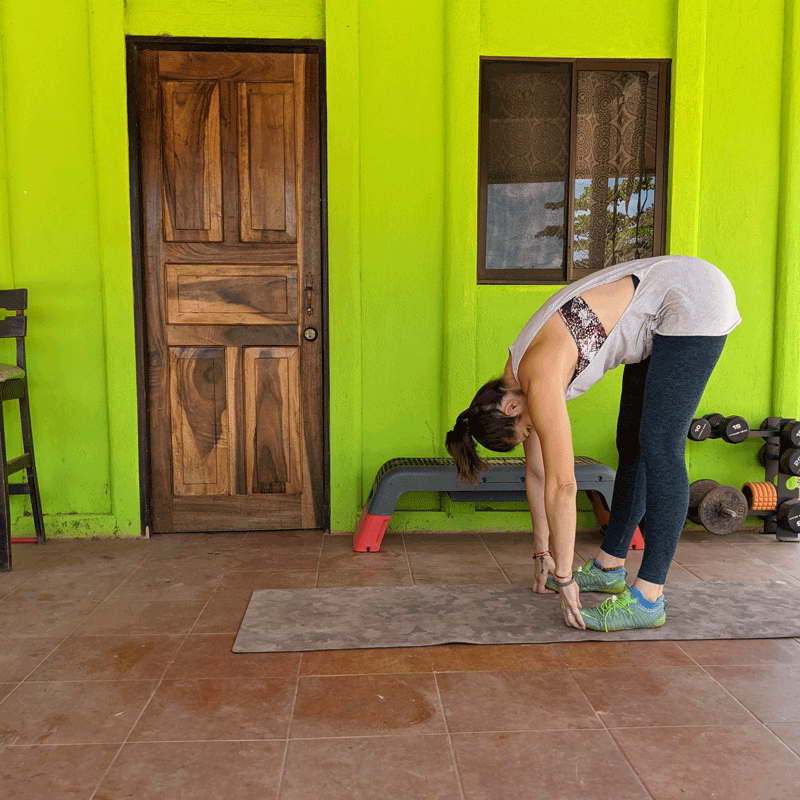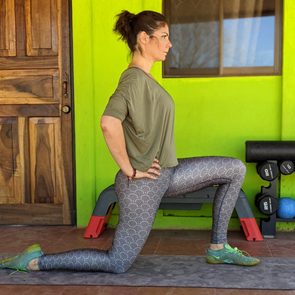The Types of Stretching Fitness Experts Recommend—and One They Avoid
Updated: Mar. 14, 2022
Stretching improves your mobility, flexibility, and range of motion. Learn the main types of stretching, plus how and when to do them.
Understanding stretching
There’s a lot of incorrect (and downright confusing) information about stretching out there. It can leave you with more questions than answers: Is ballistic stretching bad? What’s the difference between active stretching and dynamic stretching—or are they the same thing? It’s understandable if you’re scratching your head.
So, what’s an exerciser to do? Start by determining what you hope to get out of a stretching session. Then learn the different types of stretching.
Consider this your definitive guide to stretching. Use it to find the best types of stretching for your specific needs.
Why should you stretch?
Before you can fully understand the types of stretching, you need to know about the actual benefits of stretching. You might stretch as a part of an exercise routine to help prevent injury, reduce post-workout soreness, and “loosen up.” You may want to improve your flexibility—finally do that split or touch your toes. You might have low back pain and stretch in an attempt to relieve it. Or you may want to get back to moving with greater ease.
Believe it or not, stretching isn’t a fix for all of these goals, although it can help in certain circumstances. When, where, and how stretching might benefit you depends on whether you’re talking about mobility, flexibility, or range of motion. Spoiler alert: they’re not the same thing.
Mobility
Mobility, simply put, is your ability to move freely. Mobility differs from person to person and is affected by factors like your age, how healthy you are, and if you have an injury. Mobility can also refer to overall movement, like mobility while walking. It can refer to a specific movement pattern, like doing a squat. Or can refer to the mobility of a specific joint, like the right elbow or left knee.
To enjoy a high quality of life, maintaining mobility should be a major and ongoing goal. Exercise programs, including stretching, can play a role in maintaining proper mobility and enhancing or regaining mobility when it’s appropriate. Flexibility may play a role in mobility, but it’s not the same thing.
Flexibility
Flexibility refers to the range of motion at a specific joint. This differs from person to person, and while people often refer to flexibility in a way that implies more is better, that’s not always the case. A given joint can be overly flexible or have limited flexibility based on factors like age, gender, bone shape and position, medical conditions, injuries, muscle and fat amounts, and even hormones.
The average person doesn’t need to become overly flexible. While extreme flexibility may be fun for nailing the perfect Instagram-worthy yoga pose, being too flexible for your specific day-to-day movement needs may actually make you more prone to injury.
The Achilles’ heel of flexibility is instability. When a joint is overly flexible, it becomes less stable, and that makes it more likely to move in a way it’s not supposed to. Instead of striving for contortionist-level flexibility, aim to attain or maintain proper range of motion at a given joint for your specific body and needs.
Range of motion
Range of motion is essentially how the movement of a joint is measured. For instance, if you start a biceps curl with your arm fully extended, you should be able to flex your elbow, drawing the dumbbell past the 90-degree angle and closer to your shoulder. That’s a full range of motion.
Everyone has a different range: In the example above, how far you curl depends on factors like biceps size (bigger muscles make it harder to bring the dumbbell closer to your shoulder), elbow injury, and if you have other connective tissue or joint issues.
If your range of motion is limited, it means the joint isn’t moving to the expected level. In that case, your goal for stretching may be increasing the range of motion of the joint.
The main types of stretching
Done correctly, stretching can help improve your range of motion for a specific joint. If you increase your range of motion, you’ll have increased flexibility, and that ultimately leads to better mobility at that joint. Keep in mind that flexibility is joint-specific. Just because you’re very flexible at one joint does not mean you’re flexible at another.
There are a variety of ways you can stretch, which ultimately fall into four accepted categories of stretching, as defined by the American College of Sports Medicine (ACSM):
- Static stretching (done actively or passively)
- Dynamic stretching (often referred to as a dynamic warm-up or cooldown)
- Proprioceptive neuromuscular facilitation (PNF) stretching
- Ballistic stretching
One note to the list above: ballistic stretching has fallen out of popularity for a variety of reasons and isn’t widely promoted as a means to improve flexibility, even by the ACSM. So while it is a form of stretching, it’s not one most people should be engaging in on a regular basis.

Different stretching protocols
There are other types of stretching beyond the big four, and some stretching exercises combine types of stretches. For instance, yoga practices often combine static and dynamic stretching techniques to enhance range of motion, flexibility, and overall mobility. Likewise, physical therapists and coaches regularly combine static, PNF, and active stretching when working with clients.
(Try this yoga sun salutation as a dynamic warm-up)
Here’s what to know about the four main types of stretching.
Static stretching
Generally, when you think of a classic stretching routine, you’re thinking of a static stretch. These stretches are done without moving your muscles through a full range of motion as part of the exercise. Rather, you’re moving to the end of your range of motion and holding the position. Static stretches can be done passively, where you relax your muscles as you perform the stretch, or actively, where you contract your muscle groups as you stretch.
Unless you’re stretching with a partner, you’ll typically do passive static stretches. For instance, when bending forward to touch your toes, you’ll lean forward from your waist and hang, relaxing into the stretch. You might hold the position without moving for 10 to 60 seconds, repeating the stretch several times.
But stretching doesn’t have to be a solo exercise. And static stretching is a great partner activity. An active form of partner stretching might be a lying hamstring stretch.
How to do a lying hamstring stretch
- Lie on your back on the ground. With the help of your partner, lift one leg from the ground.
- With your partner’s help, bring your leg closer to your torso. Keep your knee fully extended.
- Stop when you feel a stretch along the back of your thigh.
- Passive stretch: Relax your muscles as your partner stretches you.
- Active stretch: Contract your muscles and press against your partner’s resistance, as if to lower your leg back to the floor. (Your leg should remain static, not moving, however.)
- After 10 to 20 seconds, your partner will release the resistance. Pause for a break, then repeat the stretch.
Whenever you use muscle contraction during a stretch (either contracting the muscle you’re stretching or contracting its opposing muscle) without moving the muscles being stretched, you’re engaging in a form of active static stretching.
(Try these easy static stretches.)
PNF stretching
PNF is a specific type of stretching that’s most frequently (and appropriately) used by trained professionals in athletic or therapy settings. In a nutshell, PNF stretching is a way to “trick” the body’s stretch reflex into allowing a deeper stretch. It uses a combination of passive static stretching and active static stretching facilitated by a partner in a very specific manner.
Think about it: when you move into a stretch, you know when you’ve hit the end of your natural range of motion because your body says, “Nope, can’t go any further!” You feel a tightness that can edge into pain if you push yourself past the spot you feel comfortable. This stretch reflex is protective and important to help prevent injury. But it can also be manipulated to increase range of motion. PNF stretching is a type of manipulation of this stretch reflex.
The thing to remember about PNF stretching is that it’s crucial to work with a trained professional. This type of stretching should be reserved for coaching or therapy sessions with someone who knows the ropes and won’t push you to the point of injury.
“We perform PNF stretching with our patients following an injury,” says Allen Conrad, a chiropractor in North Wales, Pennslyvania. “PNF stretches require advanced training, but we have found that PNF stretching helps the recovery time of injured muscles and that patients can return to their pre-injury state faster with this type of stretching treatment.”
How to do PNF stretching
During PNF stretching, a (trained) partner takes you to the end of your natural range of motion at a joint. At that point, you’ll contract your muscles and press against your partner’s hold—that’s an active static stretch—for a predetermined period of time, usually at least five seconds. You then release the contraction.
Because you’ve “tired out” the muscle fibers that engage in the natural stretch reflex, your muscles can be temporarily pushed beyond your initial range of motion to deepen the stretch. Your partner will stretch you again, this time in a deeper stretch. You’ll relax into the stretch this time—that’s a passive static stretch—usually for at least 10 to 30 seconds.
Dynamic stretching
Dynamic stretching is one of the most widely accepted and preferred forms of stretching, especially when included as part of a warm-up to a workout routine. Dynamic stretching involves moving a joint through a full range of motion for a minute or two.
You’ll touch the end of your range of motion but won’t push past the point of comfort. During a dynamic stretch, the muscles surrounding the joint are engaged, increasing blood flow to the area while helping prepare the muscles and joints for more vigorous exercise.
“Stretches should mimic the activity or sport you’re about to perform,” says Michelle Botsford, a physical therapist and strength and conditioning coach practicing in Portland, Oregon. “For example, prior to pitching, a baseball player would want to move through large-amplitude shoulder movements, like arm circles. I typically prescribe four to five stretches to be performed for one to two minutes each.”
It’s an appropriate form of stretching for people of all ages and fitness levels because it’s easily modified to an individual’s personal range of motion limitations.
It’s particularly helpful for athletes, who often have to achieve a larger range of motion while under more significant joint and soft tissue stress. “This makes it important for those structures to be primed for movement,” Botsford says.
Another performance-related benefit: this form of stretching isn’t associated with power or strength deficits that can occur following static stretching. Simply put, if you do static stretching before a competition, it may negatively affect your performance. That won’t happen if you warm up with dynamic stretching. (Here’s how to know when to use static vs. dynamic stretching when you exercise.)
Ballistic stretching
Fitness and health professionals aren’t so keen on ballistic stretching, and the ACSM doesn’t recommend it anymore. Not only does it appear to be less effective than other forms of stretching, but it also may lead to more injuries.
Still curious? Ballistic stretching uses the body’s momentum to bounce into a deeper stretch. For instance, if you can’t touch your toes, you might bend forward and then bounce your torso up and down, trying to force your hands closer to your toes.
The trouble with this is you’re neither relaxing into a stretch nor warming up your surrounding muscle groups to allow for a gradual increase in range of motion. At the same time, you’re moving your body with force in an uncontrolled fashion, which could lead you to push past your stretch reflex in a way that results in a muscle pull or other injury.
Some coaches do continue to use ballistic stretching in controlled settings and with athletes whose sports demand more force and power. But for the general public, it’s best avoided.
How and when to stretch
The type of stretch you do, and when you do it, depends on your goals. For instance:
Before a workout or athletic event: According to Dr. Conrad and Botsford, it’s best to engage in dynamic stretching before a workout, using this type of routine as a part of a warm-up.
If you’re hoping to increase range of motion: Go with static stretching, performing it after a workout or as a stand-alone stretching routine (like this 10-minute full-body stretching routine).
For a “comfort stretch”: Static stretching is great as a general stretch first thing in the morning or during a midday lunch break. This isn’t so much to encourage an increased range of motion as to help release tightness, make posture corrections, and increase blood flow temporarily. Bonus: even simple stretching can help relieve stress.
Programs like yoga, barre classes, and Pilates combine dynamic and static stretches in a way that can increase range of motion and strength. Plus, they’re often designed to hit all the major joints and muscle groups. These are great programs to perform daily, even if it’s just for 10 or 20 minutes.
Remember, maintaining an appropriate range of motion at all of your major joints should be a lifelong goal. When range of motion becomes limited, free movement and mobility become compromised, which makes daily living more challenging. Including stretching, whether dynamic or static, as a part of your weekly routine can help you maintain the type of mobility that will allow you to remain active, healthy, and independent as you age.






















